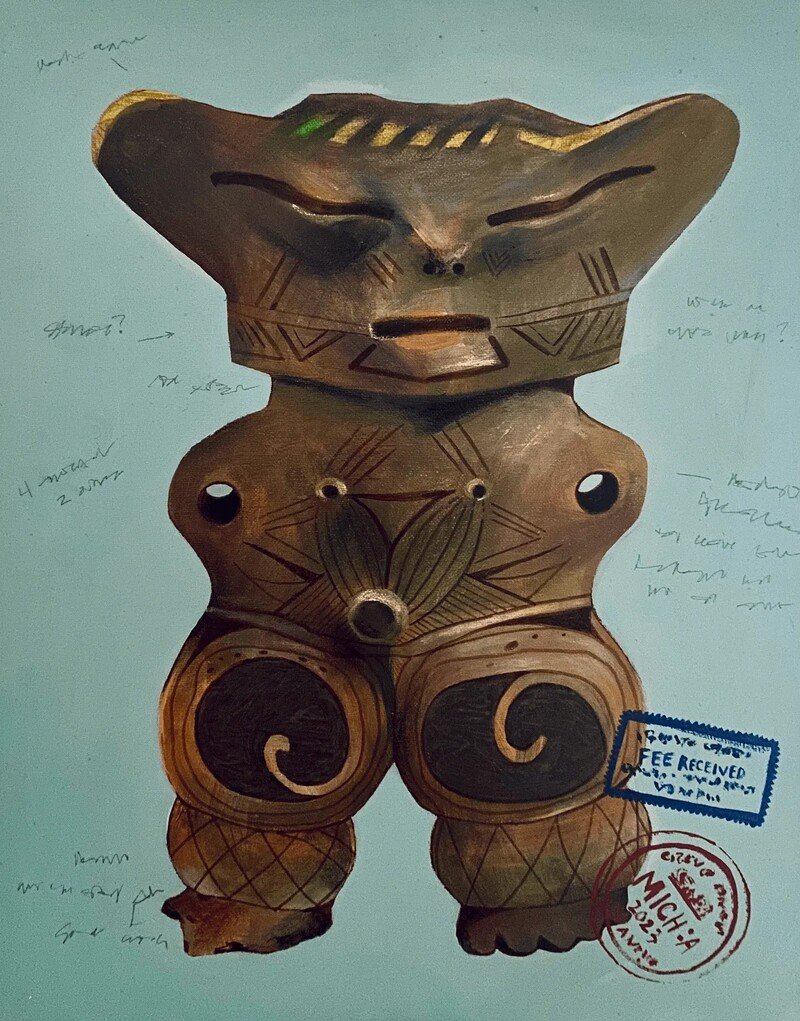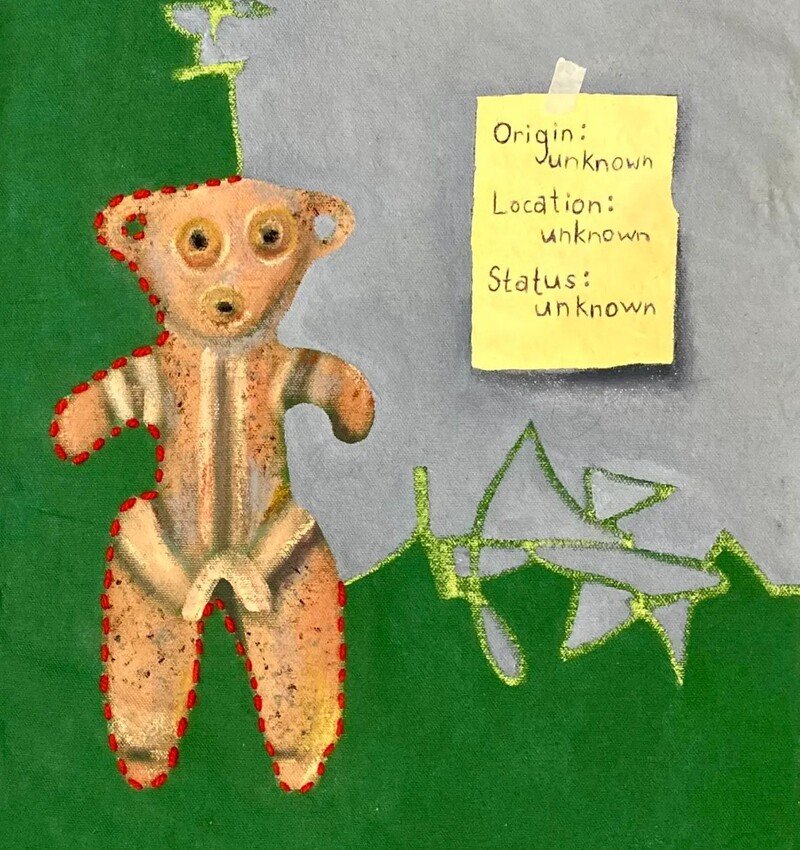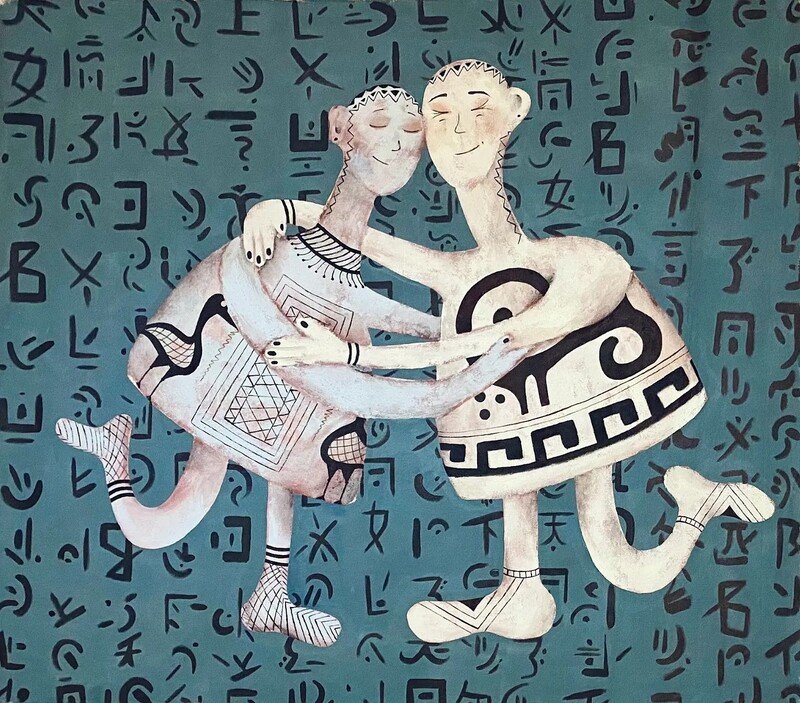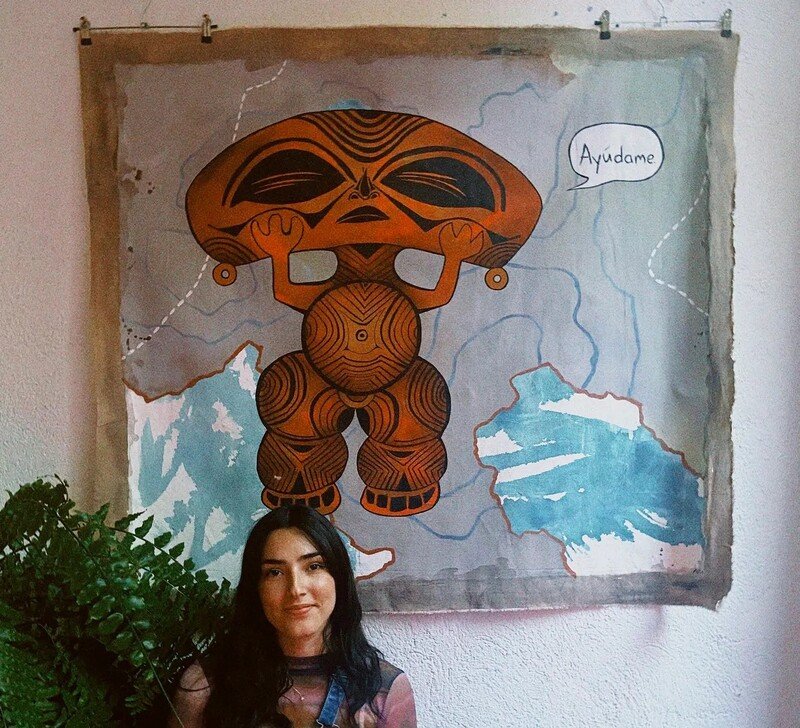A Case Study on Michelle Andrea’s “In Situ?” Artwork Series exploring profound narratives related to cultural identity, immigration and art.
In 2021, I took a bold step to pursue a career in Arts & Cultural Management. Selling all my furniture, except for a cherished wooden dressoir which will accompany me to the grave, I embarked on a journey to Barcelona for a Masters. Since then, my life has revolved around Bocadillos, art, culture, poetry, and music. Currently managing two Mixed-Media Artists and a duo composed of a Visual Artist and Music Producer, I’m actively engaged in crafting interactive cultural experiences and immersive art exhibitions through SAMAMBA.
This story focuses on my collaboration with mixed-media artist Michelle Andrea and her ‘In Situ?’ Artwork Series, which explores themes of identity, culture, and heritage. Through Andrea’s concept, research, and practice, I’ve gained invaluable insights that play a significant role by providing me with content and tools that expanded my self-awareness and self-acceptance, especially regarding being an immigrant.
Working with artists has become a fascinating journey of discovering not only their world but also insights about myself through their creations and now, I do hope you get to reflect on yours too. Put on your archeologist hat and let’s excavate Michelle Andrea’s abstract maps and unique artifacts through her “In Situ?” series!
THE ARTIST x THEIR ART
I first met Michelle Andrea in class during our Master’s Degree in Arts & Cultural Management at UIC Barcelona. We weren’t particularly close during our studies, however, the tables turned, and by the summer after we graduated, we began collaborating in various ways. This collaboration included producing events, with me appearing as a guest on her ‘What’s Art?’ podcast, and simply spending time together.
Through our conversations, I gradually came to understand Michelle Andrea not only as an artist but, to my surprise, I also gained a deeper insight into her as a person beyond her artistic works and our everyday conversations. Her art concept and research allowed me to get to know her on a profound level, and we engaged in many interesting discussions on topics we both had a strong interest in.
For example, since Art School, Michelle Andrea’s artworks have explored themes such as culture, identity, immigration, as well as nostalgia, and the personification of traditions. Her concepts became much clearer to me when I learned that Michelle had moved from Venezuela to The U.S. as a young child. Her experience of feeling different from other kids while growing up in Indiana made me empathize with her as both an artist and a person. It also provided valuable insights into the challenges and virtues of being an immigrant child, especially since I am an immigrant myself.

As I delved into Michelle Andrea’s most recent work series, ‘In Situ?’, I found myself introspecting on my own identity and personal “cultural heritage.” It became apparent how these facets significantly influence and mirror my present experiences — a sentiment shared by countless individuals who have ventured willingly or unwillingly to far-off lands. Presently residing in Catalunya, Spain, as a Brazilian, I find myself on a distinctive journey, navigating the diverse landscape of cultural differences. Undoubtedly, this mirrors the unique experience that many other foreigners encounter while residing in distant lands.
WHAT HAPPENS WHEN ONE IS TAKEN AWAY FROM THEIR OWN CULTURE?
What I appreciate most about the series is its playful approach to the topic and its special ability to materialize emotions and memories through art. Using Pop Art as the main means of expression, Andrea explores the profound narratives within emotions, transforming them into artifacts of lived experiences. Each artifact embodies universal traditions and values, becoming a way to materialize emotions, memories, and collective human experiences that may rise once one moves abroad.
The uniqueness of this series lies in its transformation of intangible culture into tangible artifacts. It also involves tracing one’s ‘life history’ by creating fantastical maps that, unlike traditional maps, lead nowhere physically but take the mind on a journey of questioning identity boundaries and cultural borders. In Michelle Andrea’s words:
“Many times I have felt misplaced or misidentified, like an object found outside of its place of origin. “In Situ?” is a series that dives into this concept using ancient artifacts as a metaphor, experimenting with storytelling and pop art to create stylized characters. No matter the style, my work is intended to spark conversation about cultural diversity and heritage.”
— MICH:A

Let’s begin by explaining the series’ name, which was conceived as a collaborative effort between Michelle and myself during my tenure as her manager and mentor. According to Oxford Languages, the term ‘In Situ’ hails from Latin roots and signifies:
IN SITU
situated in the original, natural, or existing place or position: The archaeologists were able to date the vase because it was found in situ.
adverb
in the original place.
adjective
situated in the original place.
Perfect! However, a question arises: Are the artifacts Michelle creates truly in their original place? Isn’t this series an exploration of the sensation of displacement or even the recreation of one’s identity by blending one’s past culture with their new environment? This dilemma led us to append the ‘?’ question mark to the title. The objective was to pique the viewer’s curiosity, suggesting that the original place of these artworks is uncertain, and many of their meanings can be as perplexing as the central theme of the series. This interrogative clause (?) asks the viewer to delve into ‘In Situ?’ — akin to an archaeologist unearthing an alien artifact in their excavation site.
Echoing the sentiment of conductor and composer Leonard Bernstein, who famously said, “A work of art does not answer questions, it provokes them.” Andrea’s series adeptly fulfills the role of eliciting question marks in the minds of viewers, positioning them as the central figures, as if they or their life experiences could themselves become one of these artifacts. It also provides ample breathing room for individuals to explore the theme independently and derive their own interpretations. In any case, I invite us to delve deeper into each work category within ‘In Situ?’ — categories I unearthed during my analysis of the series while mentoring Andrea.

THE OCTOPUS TEACHER OF THE ARTS & CULTURE
When people ask me about my profession, I liken myself to an octopus. Each tentacle represents a skill that I possess, and the center — my head and mind — ensures the precise utilization of each one in the correct order and at the right time. While analyzing Michelle Andrea’s work, I wear my curator hat. Later, I switch my outfit to employ my brand mentoring and management skills, guiding her with expertise in these areas (at this right moment I am using my writer hat though).
Curators possess a unique and essential ability to understand artists and their creations, uncover latent potential, and comprehend the historical and contemporary artistic landscape. Through discerning recurrent themes and techniques, they unravel an artist’s narrative and intentions, tracing the evolution of their style. Acting as cultural translators, curators bridge the gap between artists and audiences, providing context for enhanced appreciation. Their keen observation identifies trends and anticipates an artist’s impact, crucial in shaping exhibitions and collections that reflect contemporary creativity and enrich cultural discourse. In essence, a curator’s skill in deciphering patterns and categorizing artworks fosters a deeper connection between artists and audiences, shaping the trajectory of artistic movements.
In Andrea’s “In Situ?” series, I’ve delineated three categories that serve as a navigational guide to comprehending the artistic universe she has crafted. These categories facilitate a deeper understanding of her excavation — pun intended — of cultural heritage, universal human customs, and traditions:
ARTIFACTS UNDER RESEARCH
In this category, the artist delves into the profound concept of identity and cultural displacement through the metaphor of looted artifacts. The characters within the artwork symbolize individuals or intangible cultural customs (such as eating with hands) uprooted from their original context and transplanted into a foreign environment. This displacement prompts an examination and study of these figures, as their identity becomes shaped not by their narratives but by the external perceptions imposed upon them, such as ancient artifacts found and studied by archeologists of the contemporary world. Here, the artist challenges the viewer to reflect on the presumptuous act of defining someone else’s story, prompting viewers to reconsider the narratives they construct for individuals whose journeys and identities may be vastly different from their own.
“Just like looted artifacts, these characters represent the idea of coming from one culture and being taken to another. In their new environment, they have been analyzed and studied. Their identity now comes from the ideas imposed on them by a stranger who is detached from their origin.”
— MICH:A
Artworks in this section: It Belongs In A Museum • Lost & Found • It Belongs In A Museum Too.

ARTIFACTS WITH ANIMA
In this evocative section, the artist draws upon the Latin word “anima,” meaning “soul,” to encapsulate the irrational dimensions of our inner selves that influence our behavior. The site becomes a canvas for exploring the deep narratives embedded within emotions, elevating them to the status of tangible artifacts derived from lived experiences. Here, Andrea not only showcases the intangible nature of emotions but also underscores their universality. Each artifact presented becomes a vessel for universal traditions and values, serving as a tangible means to materialize the otherwise elusive realms of emotions, memories, and collective human experiences. The artist invites viewers to consider the transformative power of art in rendering the abstract tangible, creating a space where the ethereal aspects of our shared humanity find concrete expression.
Artworks in this section: Rock Hard Bond • No encuentro la tierra de mi madre (Ayudame!) • Losing Our Senses.

ABSTRACT MAPS
With her maps, Andrea introduces us to the rich inspiration behind her work, rooted in the Spanish saying “saltar el charco,” colloquially denoting travel. The literal translation, “jumping the puddle,” may seem mundane for a venture of such magnitude, yet it serves as a metaphor for the significant adventure that is when one travels. The artist beautifully acknowledges the privilege inherent in exploration — a chance to witness the diversity of the world.
The artworks in this category become a visual ode to the artist’s passion for travel, focusing on visual rhythm to craft abstract maps. These maps, born from artistic intuition and textured play, invite individual interpretation while departing from the conventional notion of physical destinations. Unlike traditional maps leading somewhere concrete, this painted map series navigates the viewer’s mind through a journey of questioning boundaries and borders. Elements borrowed from realistic maps, such as lines, dots, patterns, and shapes, converge to convey the essence of being a voyager, evoking a sense of exploration and curiosity that transcends geographical constraints.
“(…) traveling is a privilege, an opportunity to catch a glimpse of what the world is made of. The concept of place is fascinating to me and how territories are separated by lines.”
— MICH:A
Artworks in this section: Mi Map • Untitled I • Untitled II

UNDERSTANDING ONE‘S HISTORY THROUGH “IN SITU?”
It’s interesting to note that when Michelle was a child, she dreamt of becoming an archaeologist and learning about ancient cultures and heritage. Today, she’s fulfilling that childhood dream through her paintings, which provide her with valuable insights into what has always captivated her and how her most authentic self, as a child, desired to live her life: in exploration mode, immersed in art, culture, and history.
“As an immigrant, I navigate life between two cultures; Venezuelan and US American. Through “In Situ?” I delve into the realm of cultural heritage and the pursuit of defining my own cultural identity. Taking inspiration from ancient artifacts and looted art, this collection of work melds reality and fiction, forging a path toward a renewed comprehension of cultural identity.”
— MICH:A
Differently than Andrea, I wasn’t an immigrant child. However, having lived abroad when I was 16 years old and also becoming an immigrant in my 20s had its impact on my understanding of my own identity, as well as broadening my awareness of how I, as a Brazilian, was shaped not only by my “national” culture but also by the culture of my family.
Beliefs, traditions, values, and even personality traits can be passed by our ancestors and the bubble we live in. Just like a sponge, we unconsciously absorb every tiny influence surrounding us. And there’s nothing like a change of air to burst the fragile bubble and shed some light on every piece of the puzzle of our personal cultural heritage.
Slowly, throughout the years, I started to drift away from my Brazilian roots, implanting various sorts of new behaviors, which I’ve learned from international people I’ve encountered and the places I’ve lived in. I have also adopted new beliefs and values, which are different from the ones practiced at the place I call home.
But, who am I today now that I was misplaced, just like Michelle Andrea’s artifacts? Every day I listen to bossa nova, on sunny days I ride my Dutch bike through Barcelona, and I order my meals in Castellano while learning how to introduce myself among the Catalans. Am I a half Brazilian today while being not even half Dutch and not being Catalan at all?

Wrapping up our quick excavation of “In Situ?”, I’d like to ask you some personal questions. What makes you who you are? Where do your roots lie, and where has life taken you? Think about the bits of culture you’ve taken with you from your home country to a new place. If you were like an artifact, how do you think experts would describe you? Would you be seen as a genuine representation of your background, or more like a unique mix of elements that don’t usually go together?
In the rich narrative Michelle Andrea has created with this universe, we are not only invited to explore the compelling narrative of cultural identity but also prompted to embark on a personal introspection journey. Just as Andrea gracefully delves into the nuances of her Venezuelan-American experience, we, too, find resonance in the nuanced interplay of our roots, experiences, and the evolving layers of our identity. As we contemplate the artifacts of our own lives — pieces of culture, memories, and influences — we are encouraged to ask profound questions about who we are and where we belong. The gentle reminder that, much like the artist’s childhood dream, we are all explorers navigating the realms of art, culture, and history, provides a heartwarming connection. This reflection becomes an enduring invitation to cherish the diverse facets of our personal cultural heritage and appreciate the ever-evolving mosaic that shapes our authentic selves.
By XAV XAVIER
About the author
My world revolves around communications, artists, and culture, as I collaborate with numerous creative minds, galleries, venues, production companies, and collectives both in Barcelona and globally. My Master’s degree in Arts & Cultural Management from the Universidad Internacional de Catalunya honed my expertise in navigating the intersection of arts, culture and business.
With a User Experience Design background, I apply design thinking and a user-centered approach to my projects, resulting in unique endeavors such as SAMAMBA: an experience design studio that seeks to enhance human connection and critical thinking through arts, culture, and play.
Furthermore, I mentor and devote myself to artists to boost their careers and assist them with branding and business affairs such as creating personalized communication materials, designing websites, writing content, refining their artistic branding, and developing effective strategies to foster network expansion through strategic partnerships.
Last but never the least, I write articles on arts, design, culture, and society, as well as poems, which I perform in open mics and spoken words events as my melodramatic alter ego PAGOO.





Pingback: SAMAMBA Presents "Expedition In Situ?" - An Immersive Art Experience - FrikiFish Art Magazine